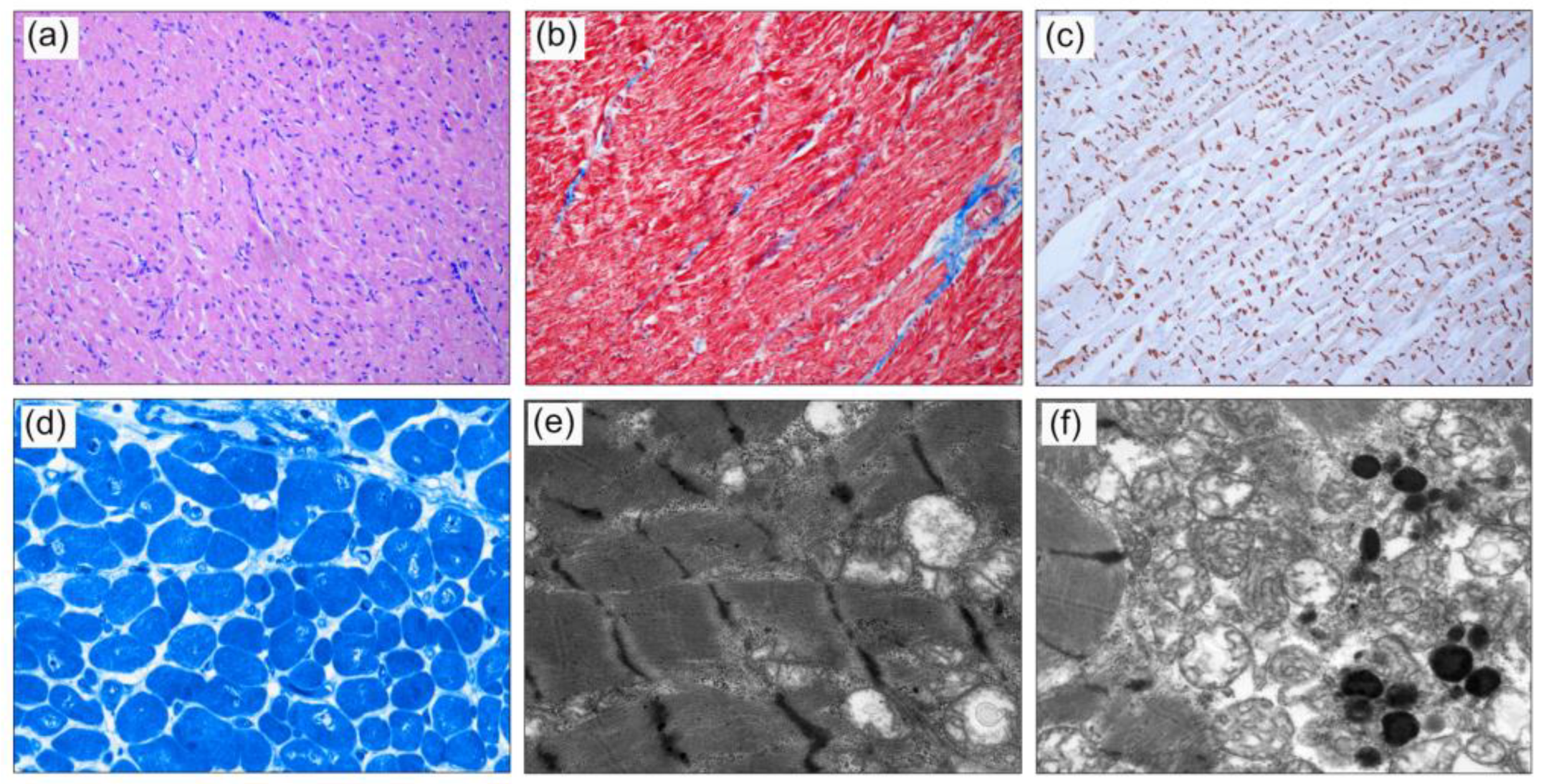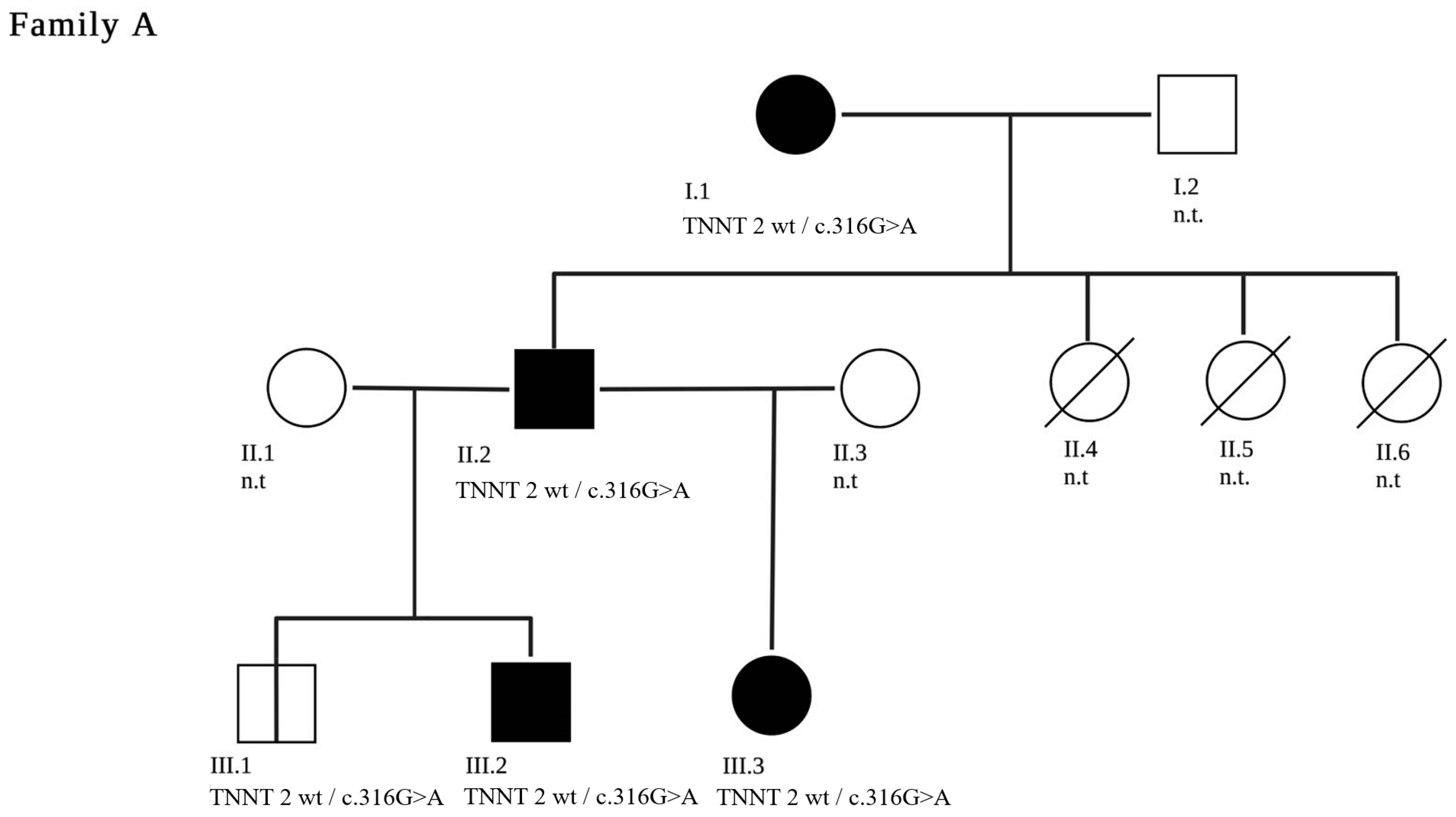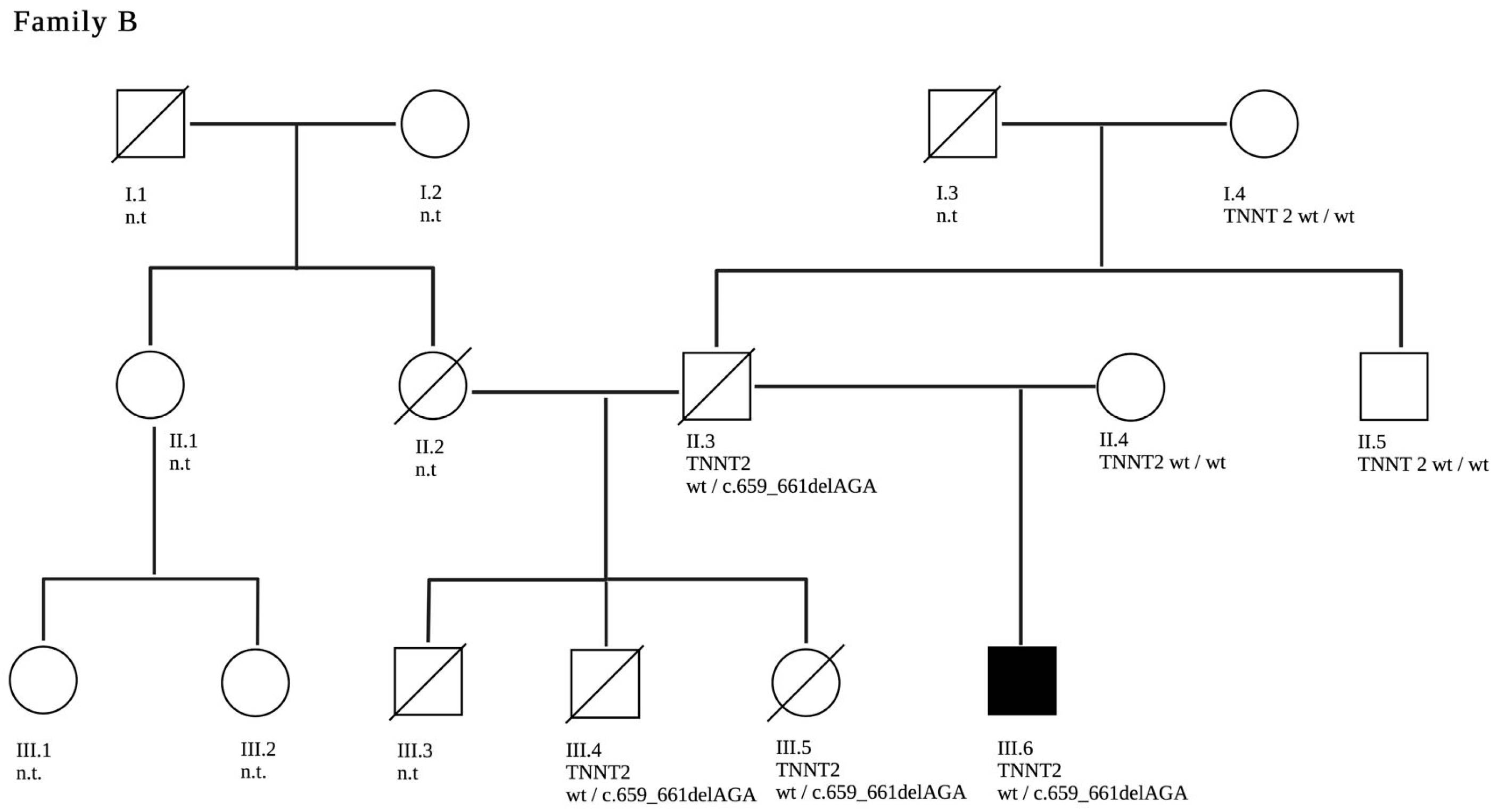Genetic Screening Reveals Heterogeneous Clinical Phenotypes in Patients with Dilated Cardiomyopathy and Troponin T2 Variants
Abstract
1. Background
Troponin T2, Cardiac Type (TNNT2)
2. Materials and Methods
2.1. Patients
2.2. Cardiac Histology
3. Results
3.1. Family A
3.2. Family B
3.3. Family C
4. Discussion
Supplementary Materials
Author Contributions
Funding
Institutional Review Board Statement
Informed Consent Statement
Data Availability Statement
Conflicts of Interest
References
- Lipshultz, S.E.; Law, Y.M.; Asante-Korang, A.; Austin, E.D.; Dipchand, A.I.; Everitt, M.D.; Hsu, D.T.; Lin, K.Y.; Price, J.F.; Wilkinson, J.D.; et al. Cardiomyopathy in Children: Classification and Diagnosis: A Scientific Statement From the American Heart Association. Circulation 2019, 140, e9–e68. [Google Scholar] [CrossRef] [PubMed]
- Zschirnt, M.; Thul, J.; Akintürk, H.; Valeske, K.; Schranz, D.; Skrzypek, S.; Müller, M.; Jux, C.; Hahn, A.; Rupp, S. Aetiology and 30-Year Long-Term Outcome of Children with Cardiomyopathy Necessitating Heart Transplantation. J. Pers. Med. 2020, 10, 251. [Google Scholar] [CrossRef] [PubMed]
- Reichart, D.; Magnussen, C.; Zeller, T.; Blankenberg, S. Dilated cardiomyopathy: From epidemiologic to genetic phenotypes: A translational review of current literature. J. Intern. Med. 2019, 286, 362–372. [Google Scholar] [CrossRef] [PubMed]
- Towbin, J.A. Inherited cardiomyopathies. Circ. J. 2014, 78, 2347–2356. [Google Scholar] [CrossRef] [PubMed]
- Wei, B.; Jin, J.P. TNNT1, TNNT2, and TNNT3: Isoform genes, regulation, and structure-function relationships. Gene 2016, 582, 1–13. [Google Scholar] [CrossRef] [PubMed]
- Bagnall, R.D.; Singer, E.S.; Wacker, J.; Nowak, N.; Ingles, J.; King, I.; Macciocca, I.; Crowe, J.; Ronan, A.; Weintraub, R.G.; et al. Genetic Basis of Childhood Cardiomyopathy. Circ. Genom. Precis Med. 2022, 15, e003686. [Google Scholar] [CrossRef] [PubMed]
- Vadgama, N.; Ameen, M.; Sundaram, L.; Gaddam, S.; Gifford, C.; Nasir, J.; Karakikes, I. Genomics England Research Consortium De novo and inherited variants in coding and regulatory regions in genetic cardiomyopathies. Hum. Genom. 2022, 16, 55. [Google Scholar] [CrossRef] [PubMed]
- Webber, S.A.; Lipshultz, S.E.; Sleeper, L.A.; Lu, M.; Wilkinson, J.D.; Addonizio, L.J.; Canter, C.E.; Colan, S.D.; Everitt, M.D.; Jefferies, J.L.; et al. Pediatric Cardiomyopathy Registry, Outcomes of restrictive cardiomyopathy in childhood and the influence of phenotype: A report from the Pediatric Cardiomyopathy Registry. Circulation 2012, 126, 1237–1244. [Google Scholar] [CrossRef] [PubMed]
- Luedde, M.; Ehlermann, P.; Weichenhan, D.; Will, R.; Zeller, R.; Rupp, S.; Müller, A.; Steen, H.; Ivandic, B.T.; Ulmer, H.E.; et al. Severe familial left ventricular non-compaction cardiomyopathy due to a novel troponin T (TNNT2) mutation. Cardiovasc. Res. 2010, 86, 452–460. [Google Scholar] [CrossRef] [PubMed]
- Mogensen, J.; Murphy, R.T.; Shaw, T.; Bahl, A.; Redwood, C.; Watkins, H.; Burke, M.; Elliott, P.M.; McKenna, W.J. Severe disease expression of cardiac troponin C and T mutations in patients with idiopathic dilated cardiomyopathy. J. Am. Coll. Cardiol. 2004, 44, 2033–2040. [Google Scholar] [CrossRef] [PubMed]
- Venkatraman, G.; Gomes, A.V.; Glenn, W.; Kerrick, L.; Potter, J.D. Characterization of troponin T dilated cardiomyopathy mutations in the fetal troponin isoform. J. Biol. Chem. 2005, 280, 17584–17592. [Google Scholar] [CrossRef] [PubMed]
- Bennett, R.L.; French, K.S.; Resta, R.G.; Doyle, D.L. Standardized human pedigree nomenclature: Update and assessment of the recommendations of the National Society of Genetic Counselors. J. Genet. Couns. 2008, 17, 424–433. [Google Scholar] [CrossRef] [PubMed]
- Richards, S.; Aziz, N.; Bale, S.; Bick, D.; Das, S.; Gastier-Foster, J.; Grody, W.W.; Hegde, M.; Lyon, E.; Spector, E.; et al. Committee, Standards and guidelines for the interpretation of sequence variants: A joint consensus recommendation of the American College of Medical Genetics and Genomics and the Association for Molecular Pathology. Genet. Med. 2015, 17, 405–424. [Google Scholar] [CrossRef] [PubMed]
- Schranz, D.; Akintuerk, H.; Bailey, L. Pulmonary Artery Banding for Functional Regeneration of End-Stage Dilated Cardiomyopathy in Young Children: World Network Report. Circulation 2018, 137, 1410–1412. [Google Scholar] [CrossRef] [PubMed]
- Dellefave, L.; McNally, E.M. Sarcomere mutations in cardiomyopathy, noncompaction, and the developing heart. Circulation 2008, 117, 2847–2849. [Google Scholar] [CrossRef] [PubMed]
- Seidel, F.; Holtgrewe, M.; Al-Wakeel-Marquard, N.; Opgen-Rhein, B.; Dartsch, J.; Herbst, C.; Beule, D.; Pickardt, T.; Klingel, K.; Messroghli, D.; et al. Pathogenic Variants Associated With Dilated Cardiomyopathy Predict Outcome in Pediatric Myocarditis. Circ. Genom. Precis Med. 2021, 14, e003250. [Google Scholar] [CrossRef] [PubMed]
- Mandawat, A.; Chattranukulchai, P.; Mandawat, A.; Blood, A.J.; Ambati, S.; Hayes, B.; Rehwald, W.; Kim, H.W.; Heitner, J.F.; Shah, D.J.; et al. Progression of Myocardial Fibrosis in Nonischemic DCM and Association with Mortality and Heart Failure Outcomes. JACC Cardiovasc. Imaging 2021, 14, 1338–1350. [Google Scholar] [CrossRef] [PubMed]
- Nicin, L.; Abplanalp, W.T.; Schanzer, A.; Sprengel, A.; John, D.; Mellentin, H.; Tombor, L.; Keuper, M.; Ullrich, E.; Klingel, K.; et al. Single Nuclei Sequencing Reveals Novel Insights Into the Regulation of Cellular Signatures in Children with Dilated Cardiomyopathy. Circulation 2021, 143, 1704–1719. [Google Scholar] [CrossRef] [PubMed]





| First Admission | Follow up at Last Contact, #, & | ||||||||
|---|---|---|---|---|---|---|---|---|---|
| Gender | Age | LVEDD (z-Score) | EF (%) | BNP (pg/mL) | Age | LVEDD (z-Score) | EF (%) | BNP (pg/mL) | |
| A.III.3 | female | 2 y | +7.2 | severely reduced | 6528 | # at the age of 2 y | # | # | # |
| A.III.2 | male | 0 m | +2.2 | normal | 206 | # at the age of 13 y | # | # | # |
| A.III.1 | male | 6 m | −0.9 | 64 | n.a. | 5 y | +3.9 | 66 | n.a. |
| B. II.3 | male | n.a. | n.a. | n.a. | n.a. | & at the age 50 y | & | & | & |
| B.III.3 | male | 5 m | +8.4 | reduced | n.a. | # at the age of 8 m, & at the age of 12 y | & | & | & |
| B.III.4 | male | 12 y | 7.7 | severely reduced | n.a. | & at the age 12 y | & | & | & |
| B.III.5 | female | 10 y | 1.5 | mildly reduced | n.a. | # at the age of 14 y, & at the age of 20 y | & | & | & |
| B.III.6 | male | 21 m | −0.4 | normal | n.a. | 12 y | +1.0 | 51 | <50 |
| C.II.1 | female | 4 y | +4.6 | 25 | 3651 | 12 y | +4.6 | 48 | 59 |
| C.II.2 | female | 14 y | +5.1 | 62 | n.a. | 16 y | +4.8 | 48 | 29 |
| C.I.2 | female | 35 y | n.a. | n.a. | n.a. | 39 y | +5.2 | n.a. | n.a. |
Disclaimer/Publisher’s Note: The statements, opinions and data contained in all publications are solely those of the individual author(s) and contributor(s) and not of MDPI and/or the editor(s). MDPI and/or the editor(s) disclaim responsibility for any injury to people or property resulting from any ideas, methods, instructions or products referred to in the content. |
© 2023 by the authors. Licensee MDPI, Basel, Switzerland. This article is an open access article distributed under the terms and conditions of the Creative Commons Attribution (CC BY) license (https://creativecommons.org/licenses/by/4.0/).
Share and Cite
Weis, A.; Krueck, S.; Dombrowsky, G.; Schänzer, A.; Jux, C.; Uebing, A.; Voges, I.; Hitz, M.-P.; Rupp, S. Genetic Screening Reveals Heterogeneous Clinical Phenotypes in Patients with Dilated Cardiomyopathy and Troponin T2 Variants. J. Pers. Med. 2023, 13, 611. https://doi.org/10.3390/jpm13040611
Weis A, Krueck S, Dombrowsky G, Schänzer A, Jux C, Uebing A, Voges I, Hitz M-P, Rupp S. Genetic Screening Reveals Heterogeneous Clinical Phenotypes in Patients with Dilated Cardiomyopathy and Troponin T2 Variants. Journal of Personalized Medicine. 2023; 13(4):611. https://doi.org/10.3390/jpm13040611
Chicago/Turabian StyleWeis, Angelika, Svenja Krueck, Gregor Dombrowsky, Anne Schänzer, Christian Jux, Anselm Uebing, Inga Voges, Marc-Phillip Hitz, and Stefan Rupp. 2023. "Genetic Screening Reveals Heterogeneous Clinical Phenotypes in Patients with Dilated Cardiomyopathy and Troponin T2 Variants" Journal of Personalized Medicine 13, no. 4: 611. https://doi.org/10.3390/jpm13040611
APA StyleWeis, A., Krueck, S., Dombrowsky, G., Schänzer, A., Jux, C., Uebing, A., Voges, I., Hitz, M.-P., & Rupp, S. (2023). Genetic Screening Reveals Heterogeneous Clinical Phenotypes in Patients with Dilated Cardiomyopathy and Troponin T2 Variants. Journal of Personalized Medicine, 13(4), 611. https://doi.org/10.3390/jpm13040611







